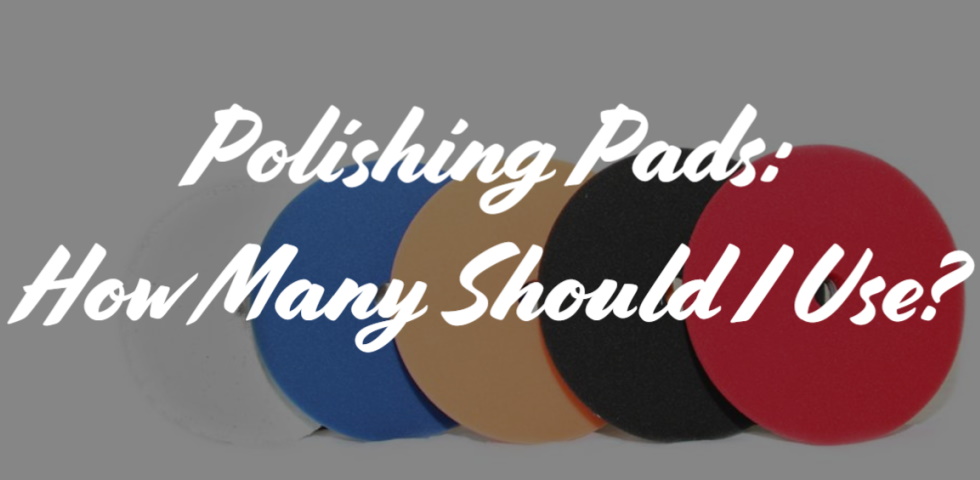Polishing Pads: How Many Should I Use?
by Reece @ DI
Whether you are picking up polishing pads for the first time, or polishing your 10th car this month, using the correct number of pads during the polishing process is extremely important.
I see this question a lot when helping customers via email, many pick up one pad and expect to polish an entire SUV. This includes no cleaning during this process, just simply using the pads from start to finish. In this article, I want to highlight why that is not a good idea and why cleaning and/or swapping out pads often will help increase your polishing results. Zach McGovern did a great job on this topic in the past and you can find his article below.
When polishing there are two general schools of thought:
- Using multiple polishing pads and cleaning them all at the end of a detail.
- Using fewer polishing pads and cleaning as you go.
Just like with most detailing steps, there is only guidelines and no 100% correct answer here. You want to find out what works best for your situation and roll with that. For myself, I personally like to swap out pads early and often. As a general rule of thumb, I use 1 pad per panel, which comes out to about 4-6 pads per car. This means if you are performing a two step polishing process, I will use 4-6 heavy correction pads and 4-6 light correction pads.
I use each pad on the hood, trunk, front quarter panels, sides, and the rear quarter panels. Once I am done with any of those sections, I toss the pad in a bucket that has a mixture of water and the Lake Country Snappy Pad Cleaner. I place a new pad onto the backing plate and proceed with polishing the next panel.
Once I am finished polishing completely, I thoroughly clean my pads and let them air dry before storing them.
This process allows me to keep heat generation down and less clear coat out of the pad’s pores. In turn, this extends the life of my pads and improves polishing results as the pads I am using are cleaner longer and less clogged with any polishing oils, clear coat, etc. Some polishes have longer work cycles as well, so swapping out pads removes spent polish and avoids re-introduction of overworked polish back onto the paint. Plus, I simply hate stopping my polishing process to clean my pads on the fly.
Now, I use mostly foam pads, but note that wool or microfiber pads need to be cleaned or blown out via compressed air more frequently. If I find myself reaching for microfiber I still swap out frequently, but I use compressed air to blow them out before I go over any section.
This general process works for me, however, my process is not the only process that works for a detailer. Take a look at some expert opinions below, which each include little nuances that work for each detailer personally.
Isaac Mittlesteadt:
If you’re good at cleaning pads and consistently blow out, use minimal product, aren’t cutting a ton of material off the vehicle, have a clean surface, than I’ve done light polishes with 1 pad.
On a typical 2 step correction, I usually use 2-3 microfiber cut pads, and 1-2 foam polishing pads. I’m a stickler for clean working and minimal product usage though. KB method user for sure, so my numbers may be lower than the “norm”
Nicholas Chopp:
If I’m going aggressive, I typically do one pad per section of the vehicle – hood and front quarter panels, sides, rear and rear quarter panels. Larger SUVs/minivans change things up some, I’ll usually add another pad to the mix.
For lighter polishing, I’ll typically try to get by with two or three pads.
I’ll use both the Rupes pad brush and a compressor to clean out my pads as I work. I also do a spritz of detailing spray after cleaning the pad and before applying new polish.
Rodney Tatum:
Light Dedicated Polishing or Quick All In One – 2 to 3 pads
1 Stage (Enhancement Correction) – 4 to 5 pads
Standard (two steps) 2 Stage Correction
a.) aggressive 1 step (compounding) 5 to 7 pads
b.) refinement 3 to 4 padsFor correction work, I will on average clean pads every other polishing cycle. But in general the more aggressively I polish and the longer I used a pad while polishing, the more vigilant I am cleaning the pads while working. Likewise with swapping out old pads for new, it will be most dependent on how aggressive my polishing step is. Overworked abrasives and excessive amounts of abraded paint on your pad will negatively affect your performance. Also aggressive pads (microfiber and wool) inherently need to be cleaned more frequently.
I don’t think it is imperative that you use quite as many pads as I use, but I want you to install the mindset of working clean. It is not uncommon for me to use more; finicky paint, multiple test spots, and curvy panels made lead to more pad usage.
While we all look at the same facts on why pads should be cleaned and swapped out during the polishing process, each and every detailer will tweak their process to fit not only the best use for when to swap out pads, but also what works best for their personal process. It is what makes detailing great and why there are general rules to each detailing step, yet tweaks to these rules within the community.
Do not forget to check out some other posts relating to pad care on our blog. Below are some of my favorites!
- Polishing Pads: How Many Do I Need?
- Pad Cleaning During and After Polishing
- How to Clean Microfiber Pads with Compressed Air
- How much product do you put on the pad? Do you prime it?
Need to add more polishing pads to your collection? Check out all of the pads we carry by clicking here.







Pad management is always an excellent, informative and often overlooked topic. So many of us started out with a new polisher, a cutting pad, a polishing pad, and a finishing pad not realizing multiple pads are needed for a full detail. It is such helpful information to new detailers. Keep spreading the word.
I have made it a habit of cleaning my pads with the Rupes Bigfoot pad brush after every pass and replacing the pad after two panels, except for the hood. I will swap the pad after doing the hood and use a minimum of 2 pads for the roof of SUVs.
I would hazard a guess most people who detail as a hobby don’t have a dedicated studio,or even a garage, compressed air, hydrolic floor jacks, Rupes polishers,1inch to 6inch, multiple chemicals and multiple pads to work on their one or two cars in their driveway or by the curb. I watch all the detail videos, but no one seems to show how to do it with reasonable products, outside, wash to polish. Just saying
Ken… we all started somewhere. I had no garage at my first house and chased the shade in my driveway. I had to bring in my supplies in winter and store them in a closet as my small shed was unheated. Any threat of rain or even drizzle I had to cancel the detail, and nothing was worse than being in the middle of detailing and have a pop up shower come down. I had a Makita rotary to cut and buff and a GEM orbital polisher to finish.
When I moved into the house I am in now (bought it brand new in 1997) it had a two car garage, but it was completely bare inside.. no drywall, only the required by code firewall. We refinanced in 2010 and turned one garage bay into a new mudroom/laundry room and added an additional garage bay. The new garage is drywalled, insulated and has a small 220 volt electric heater to warm it up in winter. It takes time to build up detailing supplies, polishers and toweling. You can put up a pop up tent or two to provide shade. Just keep plugging away!
Don’t get me wrong, I started detailing over 10 years ago, thank you Junkman ,Dylan and Adam’s, but at some point there is a limit to what one can do within a budget and real world priorities. All I’m saying is that it would be nice to see one of the established youtube detailers do a detail outside, with minimal equiptment.
Ron – Well said! Sometimes in detailing we mention optimal or suggested item quantities, techniques, etc. In terms of pads, can you polish an entire car with one pad? Of course you can, but using more will help increase your results. Start out slow, pick up the essentials and build your detailing collection as you go!